Winter Steelhead Fly Fishing: 9 Tips From The Experts
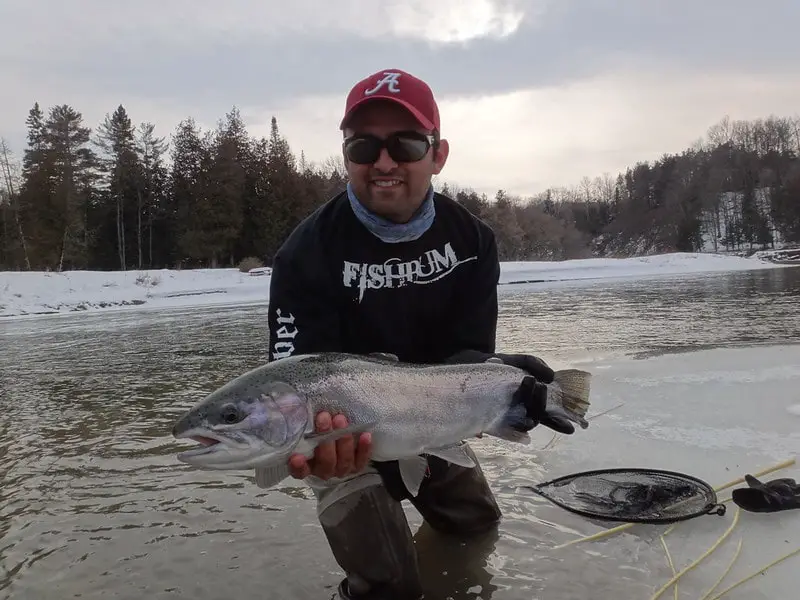
As I steelhead guide for over twenty years, I’ve figured out how to stay warm, where the steelhead holds, their feeding behaviors, best times of the day, and which baits work best.
While other anglers sometimes struggle to catch fish, I’ve adapted and adjusted, and now winter is when I have the most days when we land over 20 steelhead a day.
Winter steelhead fly fishing can be challenging with cold hands, cold feet, frozen rod guides, and tough fishing. But, winter is when there is less fishing pressure; plus, there are a lot of steelhead in the river, and they are concentrated in specific areas.
5 Quick Tips For Fly Fishing For Winter Steelhead
- Dress Properly: Layers keep you warm! Extra gloves are a very good idea. Bootfoot waders are warmer, heated insoles are my secret weapon. Keep reading for more tips on how to stay warm and my dry towel tip.
- Start Later, Leave Early: Fish later in the day on milder days or sunny days and let the sun stabilize water temps or even warm the river by a degree or two. Don’t expect to catch many steelhead in the first hour or three of the day or the last hour of the day.
- Fish Where Steelhead Hold: Fish slower deeper water and larger pools in the winter and avoid faster and smaller pools.
- Smaller Flies Are Often Best: Smaller flies fished as close to the bottom without dragging the bottom are best. Steelhead will not move far for a fly at this time of year.
- Slow It Down: Steelhead can be lethargic in winter, so they are less likely to be active and chase a fast moving fly, so if you can slow your fly down as much as possible while still presenting it naturally, you will do much better.
- Water Temperature: Water temperature is the key. The temperature itself is irrelevant to good steelhead fishing in the winter!! My rule is dropping water temps are bad, stable water temps are hit and miss, and rising water temps are good.
Winter Steelhead Fly Fishing: Keeping Warm And Dry
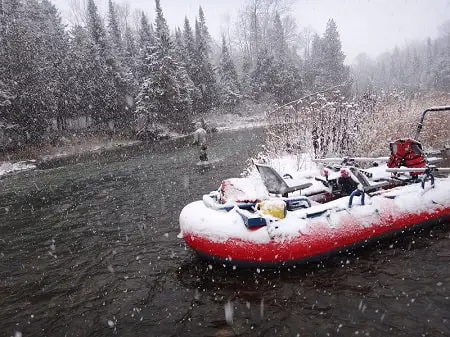
One of the keys to fly fishing for steelhead in the winter is knowing how to stay warm and dry.
Being cold with frozen fingers and frozen feet sucks, and it can take away from your concentration and can even keep you off the water.
You have probably heard people recommend layering to keep warm, and yes, this works, but only if you use the right types of layers and the right gear.
I use two or three pairs of pants on my legs and at least three shirts on my upper body. A thin base layer, a thicker base layer, and then a thick pair of pants and a thick hooded sweatshirt. The hoodie is a must!
Bring two gloves. One is a backup pair in case you drop a glove in the water. Use gloves that have been tested and are suitable for fly fishing.
Did you know that some types of waders are warmer than others, and the waders that you wear are the key to keeping your feet warmer in the winter?
After guiding hundreds of anglers with three pairs of socks on that still had frozen feet, I know for a fact that it’s not socks that will keep your feet warmer. Oversized insulated boot foot waders are by far the warmest on your feet.
But, if you want to keep using the waders you use all season, there are other tips to keep your feet warmer that I share on my page Fishing In The Winter – Stay Warm With These 10 Tips
My other tip, which both my clients and my guides really like, is to keep a dry towel tucked inside your chest waders, and in your jacket up near your chest.
Which would you prefer to dry your wet hands with after releasing a nice steelhead, a nice warm towel from your chest, or a cold half-frozen towel hanging off your belt?
Understanding Winter Steelhead Means More Fish Caught
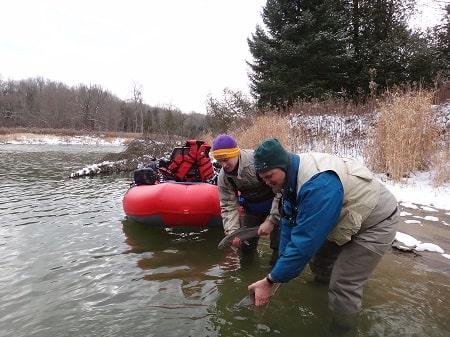
As a guide who has spent days and weeks straight fishing for winter steelhead, I have found ways of increasing the amount of steelhead my client and I catch.
I tell stories of clients hooking more than 50 steelhead a day in the dead of winter.
I know where winter steelhead hold, I know what they eat, I know what temperatures or what temperature shifts do to them, and I know what the weather will do to them. This enables me to catch a lot more fish than other anglers.
I discuss all of these things on my page, Winter Steelhead Fishing: Tips And Tactics Of Expert Guides
Guide Tip: If you try to fish steelhead the same way as you would in the fall or spring months, you will struggle. Understanding how winter steelhead feed and hold will help you catch more fish.
Fly Rods For Winter Fly Fishing For Steelhead
You can use just about any fly rod for steelhead during the winter months, and I don’t change the rod I use for winter fishing. I use the same ten-foot, seven or eight-weight fly rods for steelhead all season. See Here for my recommended steelhead rods page.
Guide Tip: Using the right rods for steelhead fishing will make it easier to cast, mend, present your fly, as well as help you fight and land more steelhead.
Fly Reels For Fly Fishing For Steelhead In The Winter
The reel is equally as important as the rod that you use in winter, except that I always recommend a fly reel that has a good smooth enclosed disc drag reel. The enclosed drag reels are less likely to freeze and lock up on you if the reel gets wet in below-freezing temperatures.
Check out the best steelhead fly reels that I like, use, and recommend to my clients.
Winter Fly Fishing Lines
Most general-purpose fly lines will work for winter fly fishing for steelhead.
I’ve also used some lines that were stiff and nearly impossible to use in below-freezing temperatures.
There are fly lines specifically designed for winter fly fishing that work better in the winter, and they can make fishing fly fishing much easier. These lines are made with cold air and cold water temperatures in mind, which means they will stay supple in cold weather.
Nymphing For Steelhead
On most steelhead rivers, nymphing is the most effective way to fly fish for steelhead, and in the winter, when the steelhead are sluggish and not as willing to chase a streamer or a swung fly, nymphing is the best choice.
I swing flies, I streamer fish, and I nymph for steelhead, and I know all of these methods well enough to tell my clients that I honestly believe that a good nymph angler will catch five times more steelhead than a good swing or streamer angler.
If you want to see my leader set up or what rods, reels, and lines I recommend for nymphing, you should check out my page Nymphing For Steelhead: The 3 Most Effective Methods
Guide Tip: Knowing what flies work best during the winter and then using a two-fly steelhead fly setup is a great way to catch more steelhead.
Streamer Fishing For Steelhead
I enjoy streamer fishing for steelhead, but I normally reserve streamer fishing for early fall and spring fishing. The reason for this is that steelhead in the winter can be sluggish, less active, and not willing to chase a streamer across the pool, especially one that darts and twitches quickly.
However, casting streamers and using a slower swing type of retrieve or a gentle twitch retrieve can work at times, especially on warmer days.
Guide Tip: When streamer fishing for steelhead in the winter, it’s best to slow your retrieve down, use smaller thinner flies that get deeper, and use flies that use materials that have movement like Marabou.
Check out my page on Streamer Fishing for Steelhead for more information.
Spey Fishing For Steelhead
Spey fishing for steelhead is growing in popularity, and it’s much more common to see anglers with two-handed fly rods making long casts and then swinging streamer flies across the river for steelhead in the winter.
This is one of my favorite ways to fly fish for steelhead simply because it’s fun and challenging.
If winter Spey fishing is something you want to try, using the Spey fishing system that our Ohio Spey fishing guide and expert Gareth discusses in his article Winter Spey Fishing For Steelhead: Tips And Tactics Used By Guides will improve your catch rate.
Guide Tip: Smaller skinny Spey flies that get down will often be better when winter fly fishing for steelhead.
Winter Steelhead Flies
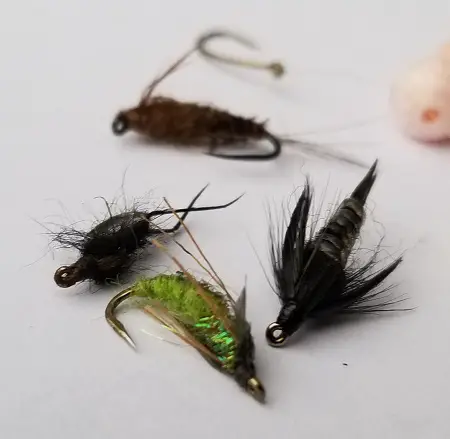
I find that flies like stoneflies, caddis larvae, and mayfly patterns like the Pheasant Tail Nymph can be excellent in the winter because these aquatic insects are the most abundant and most accessible food source at this time of year.
Other very effective flies for me are worm patterns and egg patterns.
For winter steelhead, I will often combine an egg pattern with smaller dark fly like a black stonefly nymph.
I discuss the best flies to use in the winter on my page, Winter Steelhead Flies.
Guide Tip: Match the natural forage of the rivers and use two flies when possible, and also start with smaller flies, especially if the water is low and clear.
How Water Temperatures Affect Winter Fly Fishing For Steelhead
Steelhead are sensitive to water temperatures, and I will tell you from experience that water temperatures are the key to winter steelhead fishing success!
Water temps can be the difference between a pool full of fish not eating your perfectly presented fly, and a pool full of steelhead that are eating everything you throw at them.
There is no magic temperature!! Don’t listen to guys that tell you there is.
I have experienced days in the middle of January when the water was 37F, and we caught a ton of fish, and I have had days in November when the water temps were 45F, and the fish were inactive because the water was too cold. How does this make sense?
My simple rule for winter fishing for steelhead is that regardless of the current water temperature, be it 37F or 49F, dropping water temperatures are often bad for fishing, but stable water temperature over hours can be good, and rising temperatures can be the best time to fish.
That is why when I fish when the water has dropped from 47F to 42F in a few hours, the fishing is often very tough, but when I fish colder water that has gone from 36F to 39F in a couple of hours, the fishing can be fantastic.
Slow It Down For More Steelhead
When the water gets very cold or under 45F, the steelhead start to become less active. They move into deeper slower water, and this is when they are less likely to move far to grab some food.
This is when you need to slow down your presentation as much as possible and get your flies as close to the steelhead and the bottom of the river.
Every year, my guides and I teach hundreds of anglers how to fish and one of the most important things we teach is how to get a great presentation by slowing your flies down using mending methods or tight line fishing methods.
When nymphing for steelhead in the winter, it is critical that you slow your flies down to the speed of the bottom current (not the bubbles).
I teach this in my Nymphing classes and I have made a page for my nymphing students and my clients, check it out at Fly Fishing With Nymphs.
Get It Deep For More Steelhead
Once you figure out how to slow your flies down, now you have to make sure that you get your flies as close to the bottom as possible without dragging them across the bottom.
Let me be clear, DO NOT DRAG YOUR FLIES ON BOTTOM!!
When steelhead fishing in the winter, you need to understand that the steelhead will be inches off the bottom. This is where the current is the slowest and might even be slightly warmest.
If the steelhead is going to feed, this is where they will feed as well.
The thing is that steelhead won’t move very far off the bottom to grab food when the water is ice cold, so your flies need to be in their strike zone, which could mean within 14 inches of their nose and slightly over their heads.
Fish The Middle And The Back
This brings me to where in the pool you should fish during the winter months, and where the fish hold when they are cold. I tell my clients on guide trips that I will catch fish in different parts of the pool at different times of the year.
During the coldest months, the steelhead will seek out the deepest and/or slowest water to hold in. They will often hold there all winter until spring comes.
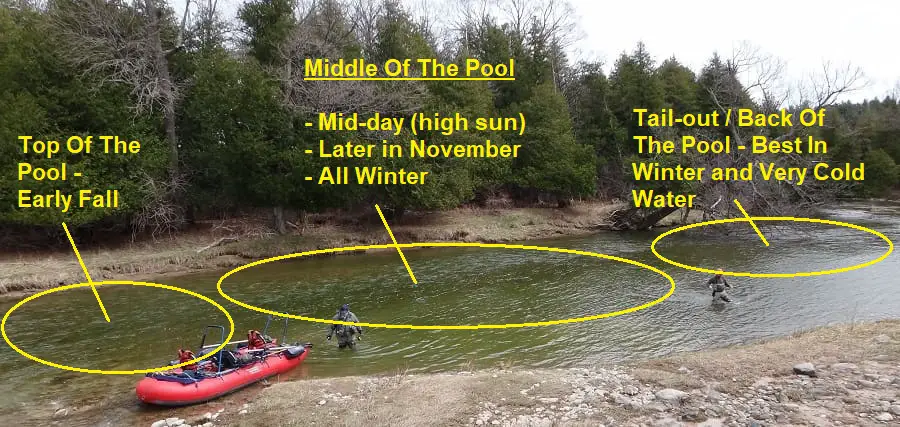
The top of the pool or head of the pool is where the faster water enters the pool. This is a great spot in the spring and fall when fish are on the move, but in the winter, it’s often void of steelhead.
The middle of the pool and the tail out, or also known as the back of the pool, is the best place to fly fish for winter steelhead because this is where the bulk of the steelhead will be holding.
Faster shallow water, rapids, runs and riffles, and small pocket water in low clear water are not good spots at this time of year, so don’t waste too much or any time there.
Tight Lines
Graham

Are you free this weekend to guide?
Hey Brian,
I’m fully booked up so I can’t help you this year, but you could always try the guides on our guide page
Good Luck,
Graham